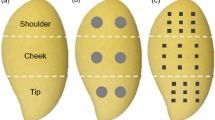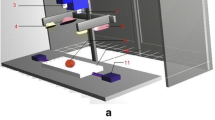Abstract
Visualizing the quality variation inside loquat fruit at pixel level is important to deeply understand its ripening process and further optimize its preharvest planting pattern and postharvest storage strategy. Total soluble solids (TSS) is a major quality attribute of loquat fruit and detecting changes in its content can be used to monitor the ripening and postharvest senescence of loquat fruit. The refractometer method cannot provide detailed TSS distribution within loquat flesh, because the analysis focuses on measuring the mean TSS of only a flesh cube, which is used to make juice for the refractometer measurement. In this study, hyperspectral imaging was used to measure and visualize internal TSS distribution within loquat fruit. Loquat fruits with different TSS contents were selected and cut at different cross sections for imaging. Different calibration and wavelength selection algorithms were applied and compared. The uninformative variable elimination by partial least square regression model with preprocessing from spectral set I (468–1026 nm) was identified as the best model for the TSS determination of loquat flesh, which had a high prediction ability with a correlation coefficient of 0.960 and residual predictive deviation of 3.513. On the basis of the best model, the quantitative TSS distribution at different cross sections inside loquat fruit was visualized at pixel level. The results showed that hyperspectral imaging is a feasible way of visualizing the spatial changes of TSS distribution inside loquat fruit at pixel level, which would be helpful to understand the detailed TSS change inside postharvest loquat fruit.





Similar content being viewed by others
References
Araujo MCU, Saldanha TCB, Galvao RKH, Yoneyama T, Chame HC, Visani V (2001) The successive projections algorithm for variable selection in spectroscopic multicomponent analysis. Chemom Intell Lab Syst 57(2):65–73
Bobelyn E, Serban A-S, Nicu M, Lammertyn J, Nicolai BM, Saeys W (2010) Postharvest quality of apple predicted by NIR-spectroscopy: study of the effect of biological variability on spectra and model performance. Postharvest Biol Technol 55(3):133–143
Cen HY, He Y (2007) Theory and application of near infrared reflectance spectroscopy in determination of food quality. Trends Food Sci Technol 18(2):72–83
Centner V, Massart DL, deNoord OE, de Jong S, Vandeginste BM, Sterna C (1996) Elimination of uninformative variables for multivariate calibration. Anal Chem 68(21):3851–3858
Chen QS, Guo ZM, Zhao JW, Ouyang Q (2012) Comparisons of different regressions tools in measurement of antioxidant activity in green tea using near infrared spectroscopy. J Pharm Biomed Anal 60:92–97
Chen X, Wu D, Guan X, Liu B, Liu G, Yan M, Chen H (2013) Feasibility of infrared and Raman spectroscopies for identification of juvenile black seabream (Sparus macrocephalus) intoxicated by heavy metals. J Agric Food Chem 61(50):12429–12435
Femenia A, Garcia-Conesa M, Simal S, Rosselló C (1998) Characterisation of the cell walls of loquat (Eriobotrya japonica L.) fruit tissues. Carbohydr Polym 35(3):169–177
Fröhlich O, Schreier P (1990) Volatile constituents of loquat (Eriobotrya japonica Lindl.) fruit. J Food Sci 55(1):176–180
Fu X-p, Li J-p, Zhou Y, Ying Y-b, Xie L-j, Niu X-y, Yan Z-k, Yu H-y (2009) Determination of soluble solid content and acidity of loquats based on FT-NIR spectroscopy. J Zhejiang Univ Sci B 10(2):120–125
Gisbert AD, Romero C, Martínez-Calvo J, Leida C, Llácer G, Badenes ML (2009) Genetic diversity evaluation of a loquat (Eriobotrya japonica (Thunb) Lindl) germplasm collection by SSRs and S-allele fragments. Euphytica 168(1):121–134
Huang G, Ruan X, Chen X, Lin D, Liu W (2014) A segmented PLS method based on genetic algorithm. Anal Methods 6(9):2900–2908
Lin S, Huang X, Cuevas J, Janick J (2007) Loquat: an ancient fruit crop with a promising future. Chronica Hortic 47(2):12–15
Lin S, Sharpe RH, Janick J (1999) Loquat: botany and horticulture. Hortic Rev 23:233–276
Liu K, Chen X, Li L, Chen H, Ruan X, Liu W (2014) A consensus successive projections algorithm—multiple linear regression method for analyzing near infrared spectra. Anal Chim Acta 858(1):16–23
Mariani NCT, da Costa RC, de Lima KMG, Nardini V, Cunha Júnior LC, Teixeira GH (2014) Predicting soluble solid content in intact jaboticaba [Myrciaria Jaboticaba (Vell.) O. Berg] fruit using near-infrared spectroscopy and chemometrics. Food Chem 159(0):458–462
Nicolaï BM, Beullens K, Bobelyn E, Peirs A, Saeys W, Theron KI, Lammertyn J (2007) Nondestructive measurement of fruit and vegetable quality by means of NIR spectroscopy: a review. Postharvest Biol Technol 46(2):99–118
Ouyang Q, Zhao JW, Pan WX, Chen QS (2016) Real-time monitoring of process parameters in rice wine fermentation by a portable spectral analytical system combined with multivariate analysis. Food Chem 190:135–141
Pan WX, Zhao JW, Chen QS, Zhang DL (2015) Simultaneous and rapid measurement of main compositions in black tea infusion using a developed spectroscopy system combined with multivariate calibration. Food Anal Methods 8(3):749–757
Pareek S, Benkeblia N, Janick J, Cao S, Yahia EM (2014) Postharvest physiology and technology of loquat (Eriobotrya japonica Lindl.) fruit. J Sci Food Agric 94(8):1495–1504
Reeves J III (1994) Effects of water on the spectra of model compounds in the short-wavelength near infrared spectral region (14,000-9091 cm-1 or 714-1100 nm). J Near Infrared Spectrosc 2(4):199–212
Suykens JAK, Vandewalle J (1999) Least squares support vector machine classifiers. Neural Process Lett 9(3):293–300
Travers S, Bertelsen MG, Petersen KK, Kucheryavskiy SV (2014) Predicting pear (cv. Clara Frijs) dry matter and soluble solids content with near infrared spectroscopy. LWT Food Sci Technol 59(2, Part 1):1107–1113
Wang A, Xie L (2014) Technology using near infrared spectroscopic and multivariate analysis to determine the soluble solids content of citrus fruit. J Food Eng 143(0):17–24
Wu D, He Y (2014) Potential of spectroscopic techniques and chemometric analysis for rapid measurement of docosahexaenoic acid and eicosapentaenoic acid in algal oil. Food Chem 158:93–100
Wu D, Sun D-W (2013a) Advanced applications of hyperspectral imaging technology for food quality and safety analysis and assessment: a review—part I: fundamentals. Innovative Food Sci Emerg Technol 19:1–14
Wu D, Sun D-W (2013b) Advanced applications of hyperspectral imaging technology for food quality and safety analysis and assessment: a review—part II: applications. Innovative Food Sci Emerg Technol 19:15–28
Wu D, Sun D-W (2013c) Application of visible and near infrared hyperspectral imaging for non-invasively measuring distribution of water-holding capacity in salmon flesh. Talanta 116:266–276
Wu D, Sun D-W (2013d) Potential of time series-hyperspectral imaging (TS-HSI) for non-invasive determination of microbial spoilage of salmon flesh. Talanta 111:39–46
Wu D, Chen X, Cao F, Sun D-W, He Y, Jiang Y (2014a) Comparison of infrared spectroscopy and nuclear magnetic resonance techniques in tandem with multivariable selection for rapid determination of ω-3 polyunsaturated fatty acids in fish oil. Food Bioprocess Technol 7(6):1555–1569
Wu D, Chen X, Zhu X, Guan X, Wu G (2011) Uninformative variable elimination for improvement of successive projections algorithm on spectral multivariable selection with different calibration algorithms for the rapid and non-destructive determination of protein content in dried laver. Anal Methods 3(8):1790–1796
Wu D, He Y, Nie P, Cao F, Bao Y (2010) Hybrid variable selection in visible and near-infrared spectral analysis for non-invasive quality determination of grape juice. Anal Chim Acta 659(1–2):229–237
Wu D, Shi H, He Y, Yu X, Bao Y (2013a) Potential of hyperspectral imaging and multivariate analysis for rapid and non-invasive detection of gelatin adulteration in prawn. J Food Eng 119(3):680–686
Wu D, Shi H, Wang S, He Y, Bao Y, Liu K (2012) Rapid prediction of moisture content of dehydrated prawns using online hyperspectral imaging system. Anal Chim Acta 726:57–66
Wu D, Sun D-W, He Y (2014b) Novel non-invasive distribution measurement of texture profile analysis (TPA) in salmon fillet by using visible and near infrared hyperspectral imaging. Food Chem 145:417–426
Wu D, Wang S, Wang N, Nie P, He Y, Sun D-W, Yao J (2013b) Application of time series-hyperspectral imaging (TS-HSI) for determining water distribution within beef and spectral kinetic analysis during dehydration. Food Bioprocess Technol 6(11):2943–2958
Zhou C-H, Li X, Zhang W-S, Sun C-D, Chen K-S (2011) Oleanolic and ursolic acid in the fruit of Eriobotrya japonica Lindl. J Med Plants Res 5(9):1735–1740
Zhou C-H, Xu C-J, Sun C-D, Li X, Chen K-S (2007) Carotenoids in white- and red-fleshed loquat fruits. J Agric Food Chem 55(19):7822–7830
Author information
Authors and Affiliations
Corresponding author
Ethics declarations
Funding
This study was funded by Natural Science Foundation of Zhejiang Province (LY14C200009) and National Natural Science Foundation of China (31401541).
Conflict of Interest
Nan Zhu declares that he has no conflict of interest. Yating Nie declares that she has no conflict of interest. Di Wu declares that he has no conflict of interest. Yong He declares that he has no conflict of interest. Kunsong Chen declares that he has no conflict of interest.
Ethical Approval
This article does not contain any studies with human participants or animals performed by any of the authors.
Informed Consent
Not applicable.
Rights and permissions
About this article
Cite this article
Zhu, N., Nie, Y., Wu, D. et al. Feasibility Study on Quantitative Pixel-Level Visualization of Internal Quality at Different Cross Sections Inside Postharvest Loquat Fruit. Food Anal. Methods 10, 287–297 (2017). https://doi.org/10.1007/s12161-016-0581-8
Received:
Accepted:
Published:
Issue Date:
DOI: https://doi.org/10.1007/s12161-016-0581-8




